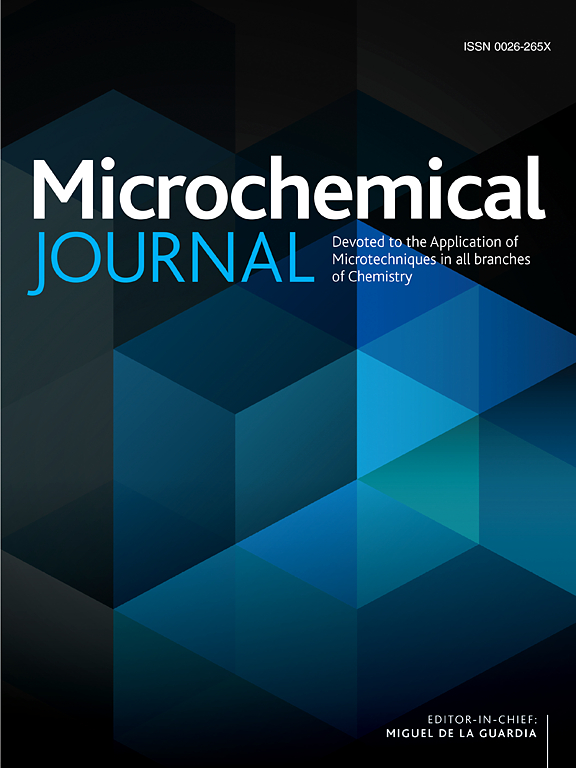Development and validation of a spectrofluorimetric method for MHPG detection in plasma via rhodamine B fluorescence quenching: a Box-Behnken design approach with application to autism spectrum disorder
IF 4.9
2区 化学
Q1 CHEMISTRY, ANALYTICAL
引用次数: 0
Abstract
This study presents the development and validation of a sensitive spectrofluorimetric method for detecting 3-methoxy-4-hydroxyphenylglycol (MHPG), a major metabolite of norepinephrine and proxy for central noradrenergic activity, in plasma based on Rhodamine B fluorescence quenching. The spectral characteristics of Rhodamine B and its ion pair complex formation with MHPG were investigated using UV–vis and fluorescence spectroscopy. Mechanistic studies employing Stern-Volmer kinetics, thermodynamic analysis, and Job's method of continuous variation revealed a static quenching mode with 1:1 complex formation stoichiometry. Critical method parameters such as pH, Rhodamine B volume, and incubation time were optimized using a Box-Behnken design of experiments, with desirability function analysis employed to maximize the quenching efficiency and sensitivity. The method was validated according to the ICH M10 guidelines and demonstrated excellent linearity (2–200 ng/mL), precision, accuracy and selectivity, with lower limits of detection and quantification of 0.655 and 1.966 ng/mL, respectively. Application to a pilot cohort of children with ASD and neurotypical controls revealed elevated plasma MHPG levels in the ASD group, although the difference did not reach statistical significance. Notably, age-related trends in MHPG levels differed markedly between groups, with a robust positive correlation observed in controls but absent in the ASD group. Sex-specific analyses further suggested more pronounced sex-related variations in noradrenergic function in ASD compared to controls. These preliminary results provide valuable insights into potential alterations of the noradrenergic system in ASD and highlight the utility of the developed spectrofluorimetric method, warranting further investigations in larger cohorts to elucidate the clinical relevance of disturbed noradrenergic function in ASD.

罗丹明B荧光猝灭法检测血浆中MHPG的开发和验证:Box-Behnken设计方法与自闭症谱系障碍的应用
本研究提出了一种基于罗丹明B荧光猝灭法检测血浆中去甲肾上腺素的主要代谢物- 3-甲氧基-4-羟基苯基乙二醇(MHPG)的灵敏荧光法,并对其进行了验证。利用紫外可见光谱和荧光光谱研究了罗丹明B及其与MHPG形成离子对的光谱特性。利用斯特恩-沃尔默动力学、热力学分析和Job的连续变化方法进行的机理研究揭示了1:1复杂形成化学计量的静态猝灭模式。采用Box-Behnken实验设计优化pH、罗丹明B体积和孵卵时间等关键方法参数,并采用可取函数分析最大化淬火效率和灵敏度。方法按照ICH M10指南进行验证,具有良好的线性(2 ~ 200 ng/mL)、精密度、准确度和选择性,检测下限和定量下限分别为0.655和1.966 ng/mL。对ASD患儿和神经正常对照组的试点队列研究显示,ASD组血浆MHPG水平升高,但差异没有达到统计学意义。值得注意的是,MHPG水平的年龄相关趋势在各组之间存在显著差异,在对照组中观察到强烈的正相关,而在ASD组中没有。性别特异性分析进一步表明,与对照组相比,ASD患者去甲肾上腺素能功能的性别相关变化更为明显。这些初步结果为ASD中去甲肾上腺素能系统的潜在改变提供了有价值的见解,并强调了所开发的荧光光谱法的实用性,需要在更大的队列中进行进一步的研究,以阐明ASD中去甲肾上腺素能功能紊乱的临床相关性。
本文章由计算机程序翻译,如有差异,请以英文原文为准。
求助全文
约1分钟内获得全文
求助全文
来源期刊

Microchemical Journal
化学-分析化学
CiteScore
8.70
自引率
8.30%
发文量
1131
审稿时长
1.9 months
期刊介绍:
The Microchemical Journal is a peer reviewed journal devoted to all aspects and phases of analytical chemistry and chemical analysis. The Microchemical Journal publishes articles which are at the forefront of modern analytical chemistry and cover innovations in the techniques to the finest possible limits. This includes fundamental aspects, instrumentation, new developments, innovative and novel methods and applications including environmental and clinical field.
Traditional classical analytical methods such as spectrophotometry and titrimetry as well as established instrumentation methods such as flame and graphite furnace atomic absorption spectrometry, gas chromatography, and modified glassy or carbon electrode electrochemical methods will be considered, provided they show significant improvements and novelty compared to the established methods.
 求助内容:
求助内容: 应助结果提醒方式:
应助结果提醒方式:


